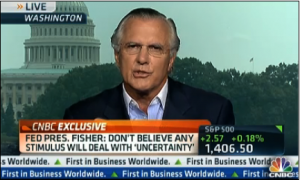 By Bill Wilson — A few recent sets of better-than-expected economic data released by government agencies in Aug. have seemingly made an additional round of quantitative easing — i.e. money-printing to purchase U.S. treasuries or mortgage-backed securities — by the Federal Reserve this year significantly less likely.
By Bill Wilson — A few recent sets of better-than-expected economic data released by government agencies in Aug. have seemingly made an additional round of quantitative easing — i.e. money-printing to purchase U.S. treasuries or mortgage-backed securities — by the Federal Reserve this year significantly less likely.
While the veracity of the data has been questioned by some, the central bank may be attempting to protect its credibility as an institution separated from politics. If the Fed were to prime the pump during this election year, it would likely be accused of trying to help Barack Obama get reelected.
When on Aug. 15 CNBC’s Maria Bartiromo asked Dallas Fed head Richard Fisher if more quantitative easing would look political, he tipped his hand and said, “I worry about that,” adding, “we are studiously non-political.”
So, perhaps the Fed is just looking for an excuse not to engage in QE3 ahead of its annual meeting at Jackson Hole, Wyo. at the end of the month.
Let’s take a look at some of the data that might give the central bank enough of a reason to do nothing.
First up was July’s unemployment numbers, which reported a gain of 163,000 jobs in the establishment survey, beating market expectations. This was positively reported in the news, and even led Barack Obama to hail the number.
Of course, the Bureau of Labor Statistics’ wider household survey for July also had contradictorily reported 195,000 fewer people were employed and 45,000 more were jobless as the unemployment rate ticked up by a tenth of a percent to 8.3 percent.
Moreover, the labor force participation rate again dropped to 63.7 percent, hardly a measure of economic strength, as it reflects 348,000 leaving the labor force all together after they could not find work. When Obama took office, that rate stood at 65.7 percent.
All together, some 4.8 million Americans have given up looking for work since Jan. 2009. If they had been included in the report, the unemployment rate would now stand at 11 percent, and the underemployed rate at 18 percent. All together, some 28.8 million cannot find full-time work in this economy or have simply given up.
These negative elements of the report alone might justify Fed bankers to consider another round of quantitative easing, but the media ignored the bad news and focused the public on the reported number of jobs created.
In another example of better-than-expected data, this time released on Aug. 14 by the U.S. Census Bureau, was retail sales for July of $403.9 billion, “an increase of 0.8 percent from the previous month,” according to the agency. Once again, the number beat expectations.
The Census Bureau noted that the result reflected seasonal adjustments that revised the July figure upward by $2 billion and the June figure downward by $5 billion. So, with the seasonal adjustment, what would have been a 0.9 percent decrease suddenly became a 0.8 percent increase in the reported sales.
Popular financial news site Zerohedge.com accused the agency of “fudging” the number, because seasonal adjustments had produced net decreases in reported retail sales figures in the month of July going back ten years, at an average decrease of $5.2 billion.
This led some clients of Morgan Stanley to inquire with their broker to see if there had been any data manipulation. Nothing to see here, Morgan Stanley replied, writing that Zerohedge was only “looking at the dollar adjustment for the level of sales in July alone. Since the main focus in the retail sales report is on the percent change in seasonally adjusted monthly retail sales, the relevant comparison is the percent change in the seasonal adjustment factor between June and July.”
Morgan Stanley’s analysis goes on to show that “the seasonal adjustment factor for July 2012 added about 2 percentage points to the monthly change in retail sales — essentially the same as in July 2007,” the last time the July calendar looked like 2012.
Sounds fairly plausible. Still, the uptick in retail sales is hard to square with other bad data showing that the U.S. economy only grew by 1.5 percent in the second quarter. Also, Europe has officially slipped into recession, China is landing hard, and Japan is still a zombie.
All of these dark clouds perhaps gave Zerohedge cause to question the retail sales data, and even for Morgan Stanley’s clients to question it, reflecting a poor perception of the current economy.
All of which is worth considering. If most observers are fairly sour on the current economy or are expecting it to get worse, whether from trouble in Europe or elsewhere, in short, if confidence is so low, wouldn’t the Fed be more likely to engage in more monetary “stimulus”?
If the stock market’s mixed reaction to better-than-expected data is any indication — the Dow Jones was flat on Aug. 14 when the retail sales numbers were posted — there is indeed a very low level of confidence.
“[I]t seems that the current rally is going through a temporary pause, in the wake of economic data that perhaps lessens expectations of Fed action in September,” said Chris Beauchamp, market analyst at IG Index told the Associated Press after trading on Aug. 14.
Traders apparently are less interested in seemingly good economic news than they are with another sugar high from the central bank.
But the Fed isn’t biting. Not yet, anyway.
Ironically, the small amount of media-spun economic good news may have given the Fed enough of an excuse to finally — after four straight years of its ridiculous balance sheet expansions and interest-rate fixing at near-zero rates — to do what it should have done from the very beginning, which is nothing.
Bill Wilson is the President of Americans for Limited Government. You can follow Bill on Twitter at @BillWilsonALG.






